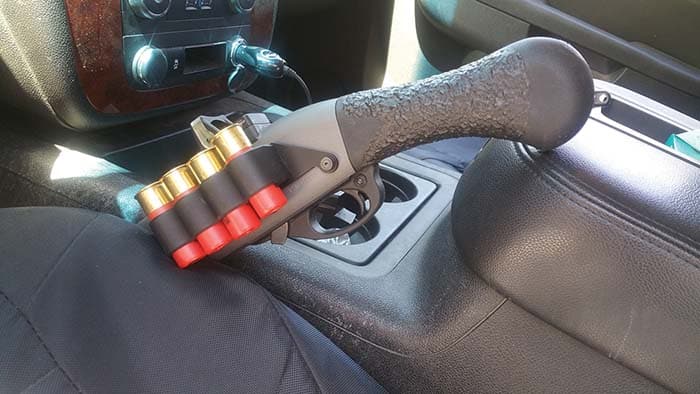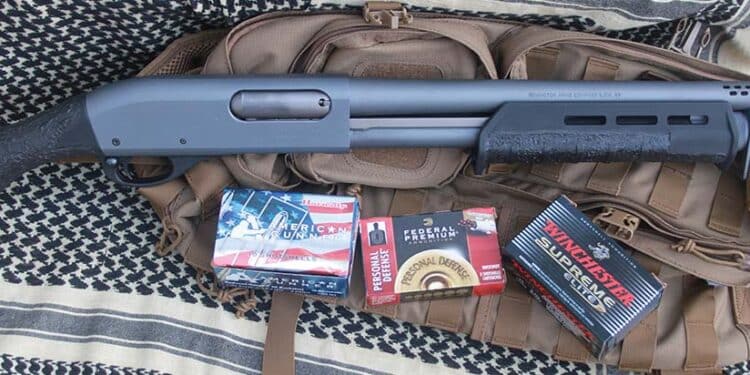By Todd Burgreen –
Many casually dismiss shotguns as no longer viable; either being smoothbore relics associated with WWI trenches or police cruiser icons that have been surpassed by the plethora of “black” rifles now on the market. The shotgun’s utility should not be doubted or held in disdain once its role is understood and applied correctly.
Whatever the label, i.e., combat/tactical/self defense, shotguns can be had in various forms ranging from double barrel, pump action, semi-automatic and, for good measure, even lever action. The Suarez Stakeout takes this a step further. Suarez labels its Stakeout as a modern “battle axe” meant to be deployed at close range by users capable of wielding its power.
The Stakeout features a textured, bird’s head pistol grip and 14-inch barrel. Do not stop reading this article by assuming it involves an exotic NFA Class 3 weapon. The Suarez Stakeout is able to be purchased with basic paperwork associated with most any other over-the-counter firearm purchase. A review of the Gun Control Act of 1968 that defines what a short-barrel shotgun consists of is the key. A shotgun that is manufactured from the start with a pistol grip and maintains an overall length greater than 26 inches is considered a firearm and not an NFA-regulated short-barrel shotgun; even with the 14-inch barrel.

The inherent flexibility of a shotgun, especially the pump action, to digest a variety of cartridge types such as birdshot, slug, buckshot, non-lethal, low recoil, breaching, etc., is its greatest attribute. The Suarez Stakeout tested herein is based on the Remington 870 pump-action 12-gauge shotgun. For sure, the Stakeout exudes an all-business air.
Research into the Stakeout concept shows its inception being a similar pattern shotgun used by the US Marshal Witness Protection teams. Other anecdotes mention various law enforcement units specializing in stake-out surveillance turning to the close-range firepower potential of the compact shotgun. High-value prisoner transport teams have also made use of shotguns similar to the Stakeout’s design.
Suarez International has taken the basic Remington 870 pistol grip shotgun and turned it into a specialized close-quarter battle weapon. No one can be all knowing in every facet of a subject as broad as personal defense. One of the places I look to for keeping me informed and grounded is Suarez International (SI). SI contains different operating entities ranging from a training division, a tactical gear store, as well as custom firearm manufacturing. No matter the personal opinion of Suarez, one can be sure that any ideas presented by Gabe Suarez and then backed up with products are well thought out and proofed during numerous training cycles and personal application in the field under the most rigorous conditions. Suarez International is offering its own take on the pistol grip shotgun with its Stakeout model. Gabe has his own LE experience deploying a shotgun similar to the Stakeout. He has taken this experience and applied improvements to his company’s offering.
The SI Stakeout is customized with features such as a ported 14-inch barrel that is also polished; this allows for both recoil reduction and increased predictability of pattern. The Stakeout’s bolt and dual operating rods are tuned, polished and coated in Aqua Terra Plus Teflon Nickel finish. The trigger group is tuned for a crisp break with new springs added. The SI Stakeout’s receiver loading port and ejection ports are de-horned, opened and polished for better ergonomics. A steel extractor is installed for increased durability/reliability. A textured forend and bird’s head pistol grip is standard; with an optional textured Magpul forend and “Stakeout Strap” available as well. A Suarez extended safety is installed to improve manipulation. Heavy duty stainless magazine tube spring is installed along with a one-plus tube magazine extension. A green fiber optic front sight is installed. A grey rust-resistant finish is applied along with a magazine tube sling mount bracket to round off the Suarez custom touches.

We depend on subject matter experts for recommendations and guidance. This approach assists in getting us up to speed as quickly as possible when it comes to increasing skill sets. My testing of the SI Stakeout was based on Suarez’s well done videos and articles discussing best practices with the pistol grip shotgun. Why not take advantage of the initial developmental experimentation?
Firing from the hip is not the best way to deploy the Stakeout effectively. Bringing the SI Stakeout eye level, while keeping it out in front away from your face, produced the best on target results. Recoil was managed by maintaining forward pressure on the forend in conjunction with pulling rearward on the bird’s head pistol grip. Gabe describes it as trying to stretch the shotgun apart. Recoil with the 12-gauge Stakeout is stout, and anyone telling you any differently should be scrutinized. Proper technique is important as well as taking advantage of the growing amount of low recoil shotgun rounds becoming available. As Gabe puts in one of his excellent Blog posts, “… this (Stakeout) is not the weapon for the frail … it takes some physical power to wield this.”
The receiver of the Stakeout is made of steel with the bolt locking into a steel barrel extension. The extra weight from the steel receiver is appreciated versus competitors who use aluminum receivers. There is something re-assuring about the power of a shotgun for any close-range engagement, which is what most civilians and LE personnel face. In terms of personal defense, buckshot loads predominate. Yes, other loads exist, but frankly not relative to the role envisioned with the Stakeout. There are various types of buckshot, but we will confine our discussion to #00 buckshot generally loaded with 8-9 .33 caliber pellets weighing 54 grains each. (As a side note, many advocate the use of #7.5 or #8 birdshot in a shotgun for use in a home to limit any chance of over penetration. A column of birdshot at close range such as across a room is lethal due to not having time to disperse.)
The Suarez Stakeout was tested with Hornady American Gunner Reduced Recoil #00 and Federal Premium Low Recoil FliteControl #00 buckshot (9 #00 pellets). The Federal Premium buckshot load utilizes a special wad for tighter buckshot patterns—thus longer effective range. Based on prior experiences with numerous buckshot loads over the years, specialized buckshot loads, such as the Federal Premium FliteControl, are a primary choice. However, the role of the Stakeout as a close-range blunderbuss could justify the use of “normal” patterning buckshot represented by the Hornady American Gunner loads; just make sure to stick with reduced recoil loads. The newer buckshot loads with specialized wads could maintain too tight a pattern, limiting its greatest attribute of lead dispersion at distances most associated with practical Stakeout deployment. Users will have to determine what bests suits their needs.
Supplementing the buckshot for testing with the SI Stakeout is the innovative Winchester PDX 1 12ga loading combining a 1-ounce slug and three #00 pellets. The Winchester PDX 1 load harkens back to the “buck-n-ball” loads used by our forefathers against the British in the Revolutionary War and each other during the American Civil War. The Winchester PDX 1 12ga loads stretch preconceived 12ga lethality notions even further with their combination of slug and buckshot. Range testing of the Winchester PDX 1 raised eyebrows with its performance combining the best of both worlds for the combat shotgun—single projectile performance and 10-inch buckshot pattern spread out to 20 yards with one of the holes being made by the 1-ounce slug! If only one load is possible for use in a combat shotgun, the Winchester PDX 1 may very well be it.
The Stakeout is a close-range hammer and was treated as such for this review. The Stakeout was evaluated via drills involving moving between barricades; think emerging from a bedroom into a hallway. Another niche role the pistol grip shotgun found in the law enforcement arena is as CQB force multiplier, especially in/around vehicles. Echo Valley Training Center (EVTC) range cars were utilized simulating responding to bad breath distance ambush.
The Stakeout’s 5+1 capacity could be augmented by a Mesa Tactical four-shell carrier on the receiver. Frankly, the role for which the Stakeout is envisioned will not require more than this capacity. If a user requires more rounds, discrete carry in pockets is suggested.
Initial hesitancy/concern about recoil management was allayed thanks to proper firing technique as outlined by Suarez International and low recoil buckshot rounds. A rhythm was discovered to make the most of natural recoil impulse to rack the slide ejecting spent hull, load fresh shell and bring Stakeout back up to line of sight. Suarez has done numerous videos explaining, and better yet, showing what I am talking about.
This Suarez Stakeout’s simplicity/reliability and raw power exemplify why the 12-gauge pump action continues to attract users. If range is point blank, the near ¾-inch diameter bore is devastating. Buckshot natural dispersion as it travels downrange creates a firepower “cone.” A 6-inch diameter pattern at 10 yards translates into a one square foot area of terminal ballistic destruction. Eight or nine .33 caliber pellets smashing into a target is a fight stopper. The Suarez Stakeout is a specialized weapon created for close-range firepower superiority.
FOR MORE INFORMATION
Suarez International www.suarezinternational.com
Echo Valley Training Center www.echovalleytraining.com
Federal Cartridge Company www.federalpremium.com
Hornady Mfg. www.hornady.com
Winchester Ammunition www.winchester.com
| This article first appeared in Small Arms Review V21N8 (October 2017) |












